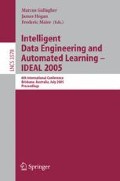Abstract
We study a method of mapping both mass spectra and sequences to feature vectors and the correlation between them. The method of calculating the feature vector from mass spectra is presented, together with a method for representing sequences. A correlation metric comparing both representations is studied. It shows strong correlation between two representation for the same peptides. It also demostrates that the effect of correlation is increased by using the longer sequences induced from the theoretical mass spectra. The method provides a promising step towards de novo sequencing.
Access this chapter
Tax calculation will be finalised at checkout
Purchases are for personal use only
Preview
Unable to display preview. Download preview PDF.
References
Perkins, D.N., Pappin, D.J.C., Creasy, D.M., Cottrell, J.S.: Probability-based protein identification by searching sequence databases using mass spectrometry data. Electrophoresis 20, 3551–3567 (1999)
Creasy, D.M., Cottrell, J.S.: Error tolerant searching of uninterpreted tandem mass spectrometry data. Proteomics 2, 1426–1434 (2002)
Eng, J.K., McCormack, A.L., Yates, J.R.: III: An approach to correlate tandem mass spectral data of peptides with amino acid sequences in a protein database. J. Am. Soc. Mass Spectrom. 5, 976–989 (1994)
Yates III, J.R., Eng, J.K., Clauser, K.R., Burlingame, A.L.: Search of Sequence Databases with Uninterpreted High-Energy Collision-Induced Dissociation Spectra of Peptides. J. Am. Soc. Mass Spectrom. 7, 1089–1098 (1996)
Dancik, V., Addona, T.A., Clauser, K.R., Vath, J.E., Pevzner, P.A.: De novo peptide sequencing via tandem mass spectrometry. J. Comp. Biol. 6, 327–342 (1999)
Chen, T., Kao, M.Y., Tepel, M., Rush, J., Church, G.M.: A dynamic programming approach to de novo peptide sequencing via tandem mass spectrometry. J. Comp. Biol. 8, 325–337 (2001)
Bafna, V., Edwards, N.: On de novo interpretation of tandem mass spectra for peptide identification. In: Annual Conference on Research in Computational Molecular Biology, Proceedings of the seventh annual international conference on Computational molecular biology, pp. 9–18 (2003)
Johnson, R.S., Martin, S.A., Biemann, K., Stults, J.T., Throck, W.J.: Novel fragmentation process of peptides by collision-induced decomposition in a tandem mass spectrometer: differentiation of leucine and isoleucine. Anal. Chem. 59, 2621–2625 (1987)
Biemann, K.: Contributions of mass spectrometry of peptide and protein structure. Biomed. Env. Mass Spectrom. 16, 99–111 (1988)
Burlet, O., Yang, C.Y., Gaskell, S.J.: Influence of cysteine to cysteic acid oxidation on the collision-activated decomposition of protonated peptides: evidence for intraionic interactions. J. Am. Soc. Mass Spectrom. 3, 337–344 (1992)
Summerfield, S.G., Cox, K.A., Gaskell, S.J.: The Promotion of d-type Ions During the Low Energy Collision-Induced Dissociation of Some Cysteic Acid-Containing Peptides. J. Am. Soc. Mass Spectrom. 8, 25–31 (1997)
Kapp, E.A., Schütz, F., Reid, G.E., Simpson, R.J.: Mining a tandem mass spectrometry database to determine the trends and global factors influencing peptide fragmentation. Anal. Chem. 75, 6251–6264 (2003)
Bartels, C.: Fast algorithm for peptide sequencing by mass spectroscopy. Biomed. Env. Mass Spectrom. 19, 363–368 (1990)
Leslie, C., Eskin, E., Noble, W.S.: The spectrum kernel: a string kernel for SVM protein classification. In: Proceedings of the Pacific Symposium on Biocomputing, pp. 564–5752 (2002)
Lee, L.: Measures of Distributional Similarity. In: 37th Annual Meeting of the ACL, pp. 25–32 (1999)
Prince, J.T., Carlson, M.W., Wang, R., Lu, P., Marcotte, E.M.: The need for a public proteomics repository. Nature Biotech. 22, 471–472 (2004)
Author information
Authors and Affiliations
Editor information
Editors and Affiliations
Rights and permissions
Copyright information
© 2005 Springer-Verlag Berlin Heidelberg
About this paper
Cite this paper
Lau, K.W., Stapley, B., Hubbard, S., Yin, H. (2005). Matching Peptide Sequences with Mass Spectra. In: Gallagher, M., Hogan, J.P., Maire, F. (eds) Intelligent Data Engineering and Automated Learning - IDEAL 2005. IDEAL 2005. Lecture Notes in Computer Science, vol 3578. Springer, Berlin, Heidelberg. https://doi.org/10.1007/11508069_51
Download citation
DOI: https://doi.org/10.1007/11508069_51
Publisher Name: Springer, Berlin, Heidelberg
Print ISBN: 978-3-540-26972-4
Online ISBN: 978-3-540-31693-0
eBook Packages: Computer ScienceComputer Science (R0)

